Electric Vehicle Charging Infrastructure and Energy Resources: A Review
Abstract
:1. Introduction
2. Electric Vehicle Charging Infrastructure
- Battery electric vehicle;
- Hybrid electric vehicles;
- Plug-in hybrid electric vehicles;
- Fuel cell electric vehicles.
2.1. Battery Electric Vehicles
2.2. Hybrid Electric Vehicles
2.3. Plug-In Hybrid Electric Vehicles
2.4. Fuel Cell Electric Vehicles (FCEVs)
2.5. Classification of Charging Infrastructure Based on Location-of-Charge
2.5.1. Home/Residential/Private Facilities
2.5.2. Semi-Public Facilities
2.5.3. Public Facilities
2.6. Classification of Charging Infrastructure Based on Charging/Refueling Technology
2.6.1. Wired Electric Vehicle Charging
2.6.2. Wireless Electric Vehicle Charging
Advances in Electric Vehicle Wireless Charging
Classifications of Wireless Charging Models in the Literature
- Optimal allocation and sizing of charging stations;
- Power electronics;
- Communications;
- Optimal scheduling and routing.
2.6.3. Battery Swapping Infrastructure
2.6.4. Hydrogen Refueling Infrastructure
3. Energy Resources for EV Applications
3.1. Lead Acid
3.2. Nickel-Based
3.2.1. Nickel Cadmium
3.2.2. Nickel Metal Hydride
3.3. Lithium-Ion
3.4. Hydrogen Fuel Cell
4. Future Outlook and Insight
5. Conclusions
Author Contributions
Funding
Data Availability Statement
Acknowledgments
Conflicts of Interest
References
- Yang, C.; Lou, L.; Yao, J.; Xie, S. On charging scheduling optimization for a wirelessly charged electric bus system. IEEE Trans. Intell. Transp. Syst. 2018, 19, 1814–1826. [Google Scholar] [CrossRef]
- Li, C.; Cao, Y.; Zhang, M.; Wang, J.; Liu, J.; Shi, H.; Geng, Y. Hidden benefits of electric vehicles for addressing climate change. Sci. Rep. 2015, 5, 9213. [Google Scholar] [CrossRef] [PubMed] [Green Version]
- Barkenbus, J. Our electric automotive future: Co2 savings through a disruptive technology. Policy Soc. 2009, 27, 399–410. [Google Scholar] [CrossRef]
- Miller, M.J.; Onar, C.O.; Chinthavali, M. Primary-side power flow control of wireless power transfer for electric vehicle charging. IEEE J. Emerg. Sel. Top. Power Electron. 2015, 3, 147–162. [Google Scholar] [CrossRef]
- Fuji-Keizai. Country-Specific Development and Dissemination Plan for Ev/Phev Charging Infrastructure. Available online: https://www.fuji-alman.co.jp/report/detail.html?code=162110917 (accessed on 23 March 2022).
- Jang, J.Y.; Suh, S.E.; Kim, W.K. System architecture and mathematical models of electric transit bus system utilizing wireless power transfer technology. IEEE Syst. J. 2015, 10, 495–506. [Google Scholar] [CrossRef]
- Bullis, K. MIT Technology Review: A Big Jump in Battery Capacity. Available online: https://www.technologyreview.com/2012/03/01/187319/a-big-jump-in-battery-capacity/ (accessed on 12 March 2022).
- McDonald, L. Why Do So Many Us Drivers Want at Least 300 Milesof Range before Considering the Purchase of an Electric Vehicle. Available online: https://evadoption.com/why-do-so-many-us-drivers-want-at-least-300-miles-of-range-before-considering-the-purchase-of-an-electric-vehicle/ (accessed on 3 December 2021).
- Jang, J.Y.; Jeong, S.; Lee, S.M. Initial energy logistics cost analysis for stationary, quasi-dynamic, and dynamic wireless charging public transportation systems. Energies 2016, 9, 483. [Google Scholar] [CrossRef] [Green Version]
- Figenbaum, E.; Kolbenstvedt, M. Electromobility in Norway—Experiences and Opportunities with Electric Vehicles. Norwegian Centre for Transport Research. TØI Report: 1281/2013. 2013; p. 170. Available online: https://www.toi.no/getfile.php?mmfileid=33828 (accessed on 24 January 2023).
- Kampshoff, P.; Kumar, A.; Peloquin, S.; Sahdev, S. Building the Electric-Vehicle Charging Infrastructure America Needs. Available online: https://www.mckinsey.com/industries/public-and-social-sector/our-insights/building-the-electric-vehicle-charging-infrastructure-america-needs. (accessed on 24 January 2023).
- IEA. World Energy Outlook 2021. Available online: https://www.iea.org/reports/world-energy-outlook-2021 (accessed on 24 October 2021).
- Yong, Y.J.; Ramachandaramurthy, K.V.; Tan, M.K.; Mithulananthan, N. A review on the state-of-the-art technologies of electric vehicle, its impacts and prospects. Renew. Sustain. Energy Rev. 2015, 49, 365–385. [Google Scholar] [CrossRef]
- US Department of Energy. Fuels and Vehicles. Available online: https://afdc.energy.gov/ (accessed on 24 January 2023).
- Un-Noor, F.; Padmanaban, S.; Mihet-Popa, L.; Mollah, M.N.; Hossain, E. A comprehensive study of key electric vehicle (ev) components, technologies, challenges, impacts, and future direction of development. Energies 2017, 10, 1217. [Google Scholar] [CrossRef] [Green Version]
- EPA. Explaining Electric & Plug-In Hybrid Electric Vehicles. Available online: https://www.epa.gov/greenvehicles/explaining-electric-plug-hybrid-electric-vehicles (accessed on 23 January 2023).
- US Department of Energy. Developing Infrastructure to Charge Electric Vehicles. Available online: https://afdc.energy.gov/fuels/electricity_infrastructure.html (accessed on 23 January 2023).
- IEA. Hydrogen. Available online: https://www.iea.org/reports/hydrogen (accessed on 25 January 2023).
- Plugless Power. Ev Unplugged. Available online: https://www.pluglesspower.com/ (accessed on 5 May 2022).
- Tesla. Introducing v3 Supercharging. Available online: https://www.tesla.com/blog/introducing-v3-supercharging (accessed on 5 April 2022).
- Gaton, B. What Is CCS Charging? Available online: https://thedriven.io/2018/12/10/what-is-ccs-charging/ (accessed on 2 February 2022).
- EV Safe Charge Inc. What Is DC Fast Charging? Available online: https://evsafecharge.com/dc-fast-charging-explained/ (accessed on 7 April 2022).
- EVExpert. Connector Types for EV Charging around the World. Available online: https://www.evexpert.eu/eshop1/knowledge-center/connector-types-for-ev-charging-around-the-world (accessed on 23 January 2023).
- Bower, G. Electric Vehicle Charging Levels Explained. Available online: https://insideevs.com/news/328781/electric-vehicle-charging-levels- (accessed on 7 April 2022).
- Moloughney, T. What are the Different Levels of Electric Vehicle Charging? Available online: https://www.forbes.com/wheels/advice/ev-charging-levels/ (accessed on 20 January 2022).
- Dalroad. An Introduction to Electric Vehicle Rapid Charging Standards. Available online: https://www.dalroad.com/resources/an-introduction-to-electric-vehicle-rapid-charging-standards/ (accessed on 12 November 2021).
- 2IEA. Global EV Outlook 2022. Available online: https://www.iea.org/reports/global-ev-outlook-2022 (accessed on 21 January 2023).
- Zhao, J.; Cai, T.; Duan, S.; Feng, H.; Chen, C.; Zhang, X. A general design method of primary compensation network for dynamic wpt system maintaining stable transmission power. IEEE Trans. Power Electron. 2016, 31, 8343–8358. [Google Scholar] [CrossRef]
- Ahmad, A.; Alam, M.S.; Chabaan, R. A comprehensive review of wireless charging technologies for electric vehicles. IEEE Trans. Transp. Electr. 2018, 4, 38–63. [Google Scholar] [CrossRef]
- Nguyen, H.T.; Alsawalhi, J.Y.; Al Hosani, K.; Al-Sumaiti, A.S.; Al Jaafari, K.A.; Byon, Y.-J.; El Moursi, M.S. Review map of comparative designs for wireless high-power transfer systems in ev applications: Maximum efficiency, zpa, and cc/cv modes at fixed resonance frequency independent from coupling coefficient. IEEE Trans. Power Electron. 2022, 37, 4857–4876. [Google Scholar] [CrossRef]
- Shaikh, P.W.; Mouftah, H.T. Intelligent charging infrastructure design for connected and autonomous electric vehicles in smart cities. In Proceedings of the 2021 IFIP/IEEE International Symposium on Integrated Network Management (IM), Bordeaux, France, 18–20 May 2021; pp. 992–997. [Google Scholar]
- Lukic, S.; Pantic, Z. Cutting the cord: Static and dynamic inductive wireless charging of electric vehicles. IEEE Electr. Mag. 2013, 1, 57–64. [Google Scholar] [CrossRef]
- Bhattacharya, S.; Tan, Y.K. Design of static wireless charging coils for integration into electric vehicle. In Proceedings of the 2012 IEEE Third International Conference on Sustainable Energy Technologies (ICSET), Kathmandu, Nepal, 24–27 September 2012; pp. 146–151. [Google Scholar] [CrossRef]
- Chen, W.; Liu, C.; Lee, C.H.T.; Shan, Z. Cost-Effectiveness Comparison of Coupler Designs of Wireless Power Transfer for Electric Vehicle Dynamic Charging. Energies 2016, 9, 906. [Google Scholar] [CrossRef] [Green Version]
- Mohamed, A.A.; Lashway, R.C.; Mohammed, O. Modeling and feasibility analysis of quasi-dynamic wpt system for ev ap-plications. IEEE Trans. Transp. Electr. 2017, 3, 343–353. [Google Scholar] [CrossRef]
- Mi, C.C.; Buja, G.; Choi, Y.S.; Rim, T.C. Modern advances in wireless power transfer systems for roadway powered electric vehicles. IEEE Trans. Ind. Electron. 2016, 63, 6533–6545. [Google Scholar] [CrossRef]
- Jeong, S.; Jang, J.Y.; Kum, K. Economic analysis of the dynamic charging electric vehicle. IEEE Trans. Power Electron. 2015, 30, 6368–6377. [Google Scholar] [CrossRef]
- Electreon. A Milestone in Urban Wireless Electric Road Systems. Available online: https://electreon.com/projects/tel-aviv (accessed on 2 June 2022).
- NDUCTEV. Powering the Commercial Fleets of the Future. Available online: https://inductev.com/#wirelesscharging (accessed on 28 January 2023).
- Mahesh, A.; Chokkalingam, B.; Mihet-Popa, L. Inductive wireless power transfer charging for electric vehicles—A review. IEEE Access 2021, 9, 137667–137713. [Google Scholar] [CrossRef]
- Zhang, S.; Gajpal, Y.; Appadoo, S.; Abdulkader, M. Electric vehicle routing problem with recharging stations for minimizing energy consumption. Int. J. Prod. Econ. 2018, 203, 404–413. [Google Scholar] [CrossRef]
- Mehar, S.; Senouci, M.S. An optimization location scheme for electric charging stations. In Proceedings of the 2013 International Conference on Smart Communications in Network Technologies (SaCoNeT), Paris, France, 17–19 June 2013; pp. 1–5. [Google Scholar] [CrossRef]
- Mouhrim, N.; El Hilali Alaoui, A.; Boukachour, J. Pareto efficient allocation of an in-motion wireless charging infrastructure for electric vehicles in a multipath network. Int. J. Sustain. Transp. 2019, 13, 419–432. [Google Scholar] [CrossRef]
- Şengör, İ.; Erenoğlu, A.K.; Erdinç, O.; Taşcıkaraoğlu, A.; Taştan, İ.C.; Büyük, A.F. Optimal sizing and siting of ev charging stations in a real distribution system environment. In Proceedings of the 2020 International Conference on Smart Energy Systems and Technologies (SEST), Istanbul, Turkey, 7–9 September 2020; pp. 1–6. [Google Scholar] [CrossRef]
- Aggarwal, S.; Singh, K.A. Impact analysis of electric vehicle charging station integration with distributed generators on power systems. Int. J. Circuit Theory Appl. 2021, 49, 1811–1827. [Google Scholar] [CrossRef]
- Alwesabi, Y.; Wang, Y.; Avalos, R.; Liu, Z. Electric bus scheduling under single depot dynamic wireless charging infrastructure planning. Energy 2020, 213, 118855. [Google Scholar] [CrossRef]
- Kosmanos, D.; Maglaras, L.A.; Mavrovouniotis, M.; Moschoyiannis, S.; Argyriou, A.; Maglaras, A.; Janicke, H. Route optimization of electric vehicles based on dynamic wireless charging. IEEE Access 2018, 6, 42551–42565. [Google Scholar] [CrossRef]
- Zhang, S.; James, J. Electric vehicle dynamic wireless charging system: Optimal placement and vehicle-to-grid scheduling. IEEE Internet Things J. 2022, 9, 6047–6057. [Google Scholar] [CrossRef]
- Erdinc, O.; Tascikaraoglu, A.; Paterakis, N.G.; Dursun, I.; Sinim, M.C.; Catalão, J.P. Optimal sizing and siting of dis-tributed generation and EV charging stations in distribution systems. In Proceedings of the 2017 IEEE PES Innovative Smart Grid Technologies Conference Europe (ISGT-Europe), Turin, Italy, 26–29 September 2017; pp. 1–6. [Google Scholar] [CrossRef]
- Jin, Y.; Xu, J.; Wu, S.; Xu, L.; Yang, D. Enabling the wireless charging via bus network: Route scheduling for electric vehicles. IEEE Trans. Int. Trans. Syst. 2021, 22, 1827–1839. [Google Scholar] [CrossRef]
- Bozorgi, A.M.; Farasat, M.; Mahmoud, A.A. Time and energy efficient routing algorithm for electric vehicles based on historical driving data. IEEE Trans. Intel. Veh. 2017, 2, 308–320. [Google Scholar] [CrossRef]
- Kyriakakis, N.A.; Stamadianos, T.; Marinaki, M.; Marinakis, Y. The electric vehicle routing problem with drones: An energy minimization approach for aerial deliveries. Clean. Logist. Supply Chain 2022, 4, 100041. [Google Scholar] [CrossRef]
- Alamatsaz, K.; Hussain, S.; Lai, C.; Eicker, U. Electric Bus Scheduling and Timetabling, Fast Charging Infrastructure Planning, and Their Impact on the Grid: A Review. Energies 2022, 15, 7919. [Google Scholar] [CrossRef]
- Cao, Y.; Kaiwartya, O.; Zhuang, Y.; Ahmad, N.; Sun, Y.; Lloret, J. A decentralized deadline-driven electric vehicle charging recommendation. IEEE Syst. J. 2019, 13, 3410–3421. [Google Scholar] [CrossRef] [Green Version]
- Cao, Y.; Kaiwartya, O.; Wang, R.; Jiang, T.; Aslam, N.; Sexton, G. Toward efficient, scalable, and coordinated on-the-move EV charging management. IEEE Wirel. Commun. 2017, 24, 66–73. [Google Scholar] [CrossRef]
- Machura, P.; Li, Q. A critical review on wireless charging for electric vehicles. Renew. Sustain. Energy Rev. 2019, 104, 209–234. [Google Scholar] [CrossRef] [Green Version]
- Li, S.; Mi, C.C. Wireless power transfer for electric vehicle applications. IEEE J. Emerg. Sel. Top. Power Electron. 2015, 3, 4–17. [Google Scholar] [CrossRef]
- Winton, N. Battery-Swapping Revival Could Threaten Electric Car Charging Networks. Available online: https://www.forbes.com/sites/neilwinton/2022/09/12/battery-swapping-revival-could-threaten-electric-car-charging-networks/ (accessed on 22 January 2023).
- The Tesla Team. Battery Swap Pilot Program. Available online: https://www.tesla.com/blog/battery-swap-pilot-program (accessed on 27 January 2023).
- Revankar, S. Tesla Battery Swap Station: What Happened to Elon’s Claim on Fully Charging Tesla in 90 Seconds? Available online: https://www.vehiclesuggest.com/what-happened-tesla-battery-swap/ (accessed on 27 January 2023).
- Grand View Research. Battery Swapping Charging Infrastructure Market Size, Share & Trends Analysis Report By Vehicle Type (Three-, Two-Wheeler), by Service Type (Pay-per-Use, Subscription), by Region, and Segment Forecasts, 2022–2030. Available online: https://www.grandviewresearch.com/industry-analysis/battery-swapping-charging-infrastructure-market-report (accessed on 24 January 2023).
- Bellan, R. Ample’s Co-Founder Explains What It Takes to Scale EV Battery Swapping. Available online: https://techcrunch.com/2022/12/28/amples-founder-explains-what-it-takes-to-scale-ev-battery-swapping/ (accessed on 26 January 2023).
- Lienert, P.; Carey, N.; Shirouzu, N. Inside China’s Electric Drive for Swappable Car Batteries. Available online: https://www.reuters.com/business/autos-transportation/inside-chinas-electric-drive-swappable-car-batteries-2022-03-24/ (accessed on 21 January 2023).
- Hydrogen Mobility Europe. Hydrogen Refuelling Infrastructure. Available online: https://h2me.eu/about/hydrogen-refuelling-infrastructure/ (accessed on 22 January 2023).
- H2Stations. 14th Annual Assessment. Available online: https://www.h2stations.org (accessed on 27 January 2023).
- Fan, X.; Liu, B.; Liu, J.; Ding, J.; Han, X.; Deng, Y.; Lv, X.; Xie, Y.; Chen, B.; Hu, W.; et al. Battery technologies for grid-level large-scale electrical energy storage. Trans. Tianjin Univ. 2020, 26, 92–103. [Google Scholar] [CrossRef] [Green Version]
- Bukhari, S.M.A.S.; Maqsood, J.; Baig, M.Q.; Ashraf, S.; Khan, T.A. Comparison of Characteristics—Lead Acid, Nickel Based, Lead Crystal and Lithium Based Batteries. In Proceedings of the 2015 17th UKSim-AMSS International Conference on Modelling and Simulation (UKSim), Cambridge, UK, 25–27 March 2015; pp. 444–450. [Google Scholar] [CrossRef]
- Vidyanandan, K.V. Batteries for Electric Vehicles. Energy Scan 2019, 1, 1–7. [Google Scholar]
- Power Me UP. Eneloop XX vs. Turnigy 2400 Cycle Testing. Available online: https://www.candlepowerforums.com/threads/eneloop-xx-vs-turnigy-2400-cycle-testing.391756/ (accessed on 23 November 2022).
- EneloopProduct Lineup. Panasonic.net. Available online: https://web.archive.org/web/20140203082140/http://panasonic.net/energy/battery/eneloop/lineup/ (accessed on 10 November 2022).
- Battery University. BU-203: Nickel Based Batteries. Available online: https://batteryuniversity.com/article/bu-203-nickel-based-batteries (accessed on 11 November 2022).
- May, G.J.; Davidson, A.; Monahov, B. Lead batteries for utility energy storage: A review. J. Energy Storage 2018, 15, 145–157. [Google Scholar] [CrossRef]
- Szałek, A.; Pielecha, I.; Cieslik, W. Fuel Cell Electric Vehicle (FCEV) Energy Flow Analysis in Real Driving Conditions (RDC). Energies 2021, 14, 5018. [Google Scholar] [CrossRef]
- Du, Z.; Liu, C.; Zhai, J.; Guo, X.; Xiong, Y.; Su, W.; He, G. A Review of Hydrogen Purification Technologies for Fuel Cell Ve-hicles. Catalysts 2021, 11, 393. [Google Scholar] [CrossRef]
- Akinyele, D.; Olabode, E.; Amole, A. Review of Fuel Cell Technologies and Applications for Sustainable Microgrid Systems. Inventions 2020, 5, 42. [Google Scholar] [CrossRef]
- Nerad, J.R. How a Fuel Cell Vehicle Works. Available online: https://www.jdpower.com/cars/shopping-guides/how-a-fuel-cell-vehicle-works (accessed on 25 January 2023).
- PowerPSSonic. Lead Acid Batteries. Available online: https://www.power-sonic.com/batteries/sealed-lead-acid/ (accessed on 10 September 2022).
- Powersonic Batteries. Technical Manual: Sealed Lead Acid Batteries. Available online: http://www.ken-lab.com/uploads/6/6/1/3/66134969/powersonicmanual.pdf (accessed on 25 May 2022).
- Crompton, T.R. Battery Reference Book, 3rd ed.; Newnes: Woburn, MA, USA, 2000; pp. 1–10. ISBN 07506-4625-X. [Google Scholar]
- Redondo-Iglesias, E.; Venet, P.; Pelissier, S. Measuring Reversible and Irreversible Capacity Losses on Lithium-Ion Batteries. In Proceedings of the 2016 IEEE Vehicle Power and Propulsion Conference (VPPC), Hangzhou, China, 17–20 October 2016; pp. 1–7. [Google Scholar] [CrossRef] [Green Version]
- Valøen, L.O.; Shoesmith, M.I. The effect of PHEV and HEV duty cycles on battery and battery pack performance. In Proceedings of the 2007 Plug-in Highway Electric Vehicle Conference, Winnipeg, MB, Canada, 1–2 November 2007; pp. 4–5. [Google Scholar]
- PowerStream. NiMH Battery Charging Basics. Available online: https://www.powerstream.com/NiMH.htm (accessed on 5 August 2022).
- Zhu, W.; Zhu, Y.; Davis, Z.; Tatarchuk, B. Energy efficiency and capacity retention of Ni–MH batteries for storage applications. Appl. Energy 2013, 106, 307–313. [Google Scholar] [CrossRef]
- Sabihuddin, S.; Kiprakis, A.E.; Mueller, M. A numerical and graphical review of energy storage technologies. Energies 2015, 8, 172–216. [Google Scholar] [CrossRef] [Green Version]
- Kirubakaran, A.; Jain, S.; Nema, R.K. A review on fuel cell technologies and power electronic interface. Renew. Sustain. Energy Rev. 2009, 13, 2430–2440. [Google Scholar] [CrossRef]
- Edison Electric Institute. Electric Vehicle Sales and the Charging Infrastructure Required Through 2030. Available online: https://www.eei.org/-/media/Project/EEI/Documents/Issues-and-Policy/Electric-Transportation/EV-Forecast--Infrastructure-Report.pdf (accessed on 30 January 2023).
- BloombergNEF. Battery Pack Prices Fall to an Average of $132/kWh, But Rising Commodity Prices Start to Bite. Available online: https://about.bnef.com/blog/battery-pack-prices-fall-to-an-average-of-132-kwh-but-rising-commodity-prices-start-to-bite/ (accessed on 30 January 2023).
- White House. FACT SHEET: President Biden Signs Executive Order Catalyzing America’s Clean Energy Economy Through Federal Sus-tainability. Available online: https://www.whitehouse.gov/briefing-room/statements-releases/2021/12/08/fact-sheet-president-biden-signs-executive-order-catalyzing-americas-clean-energy-economy-through-federal-sustainability/ (accessed on 27 January 2023).
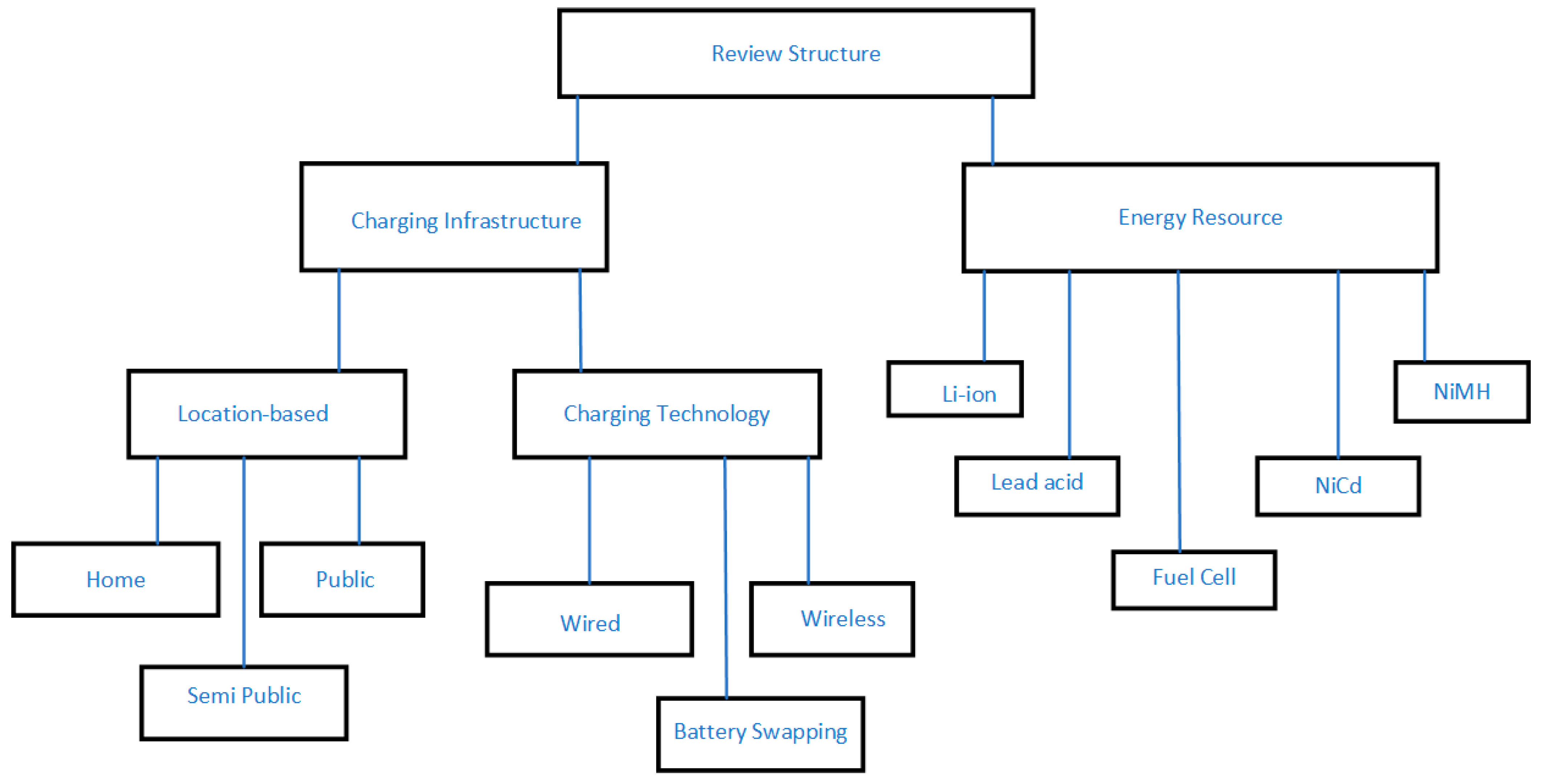




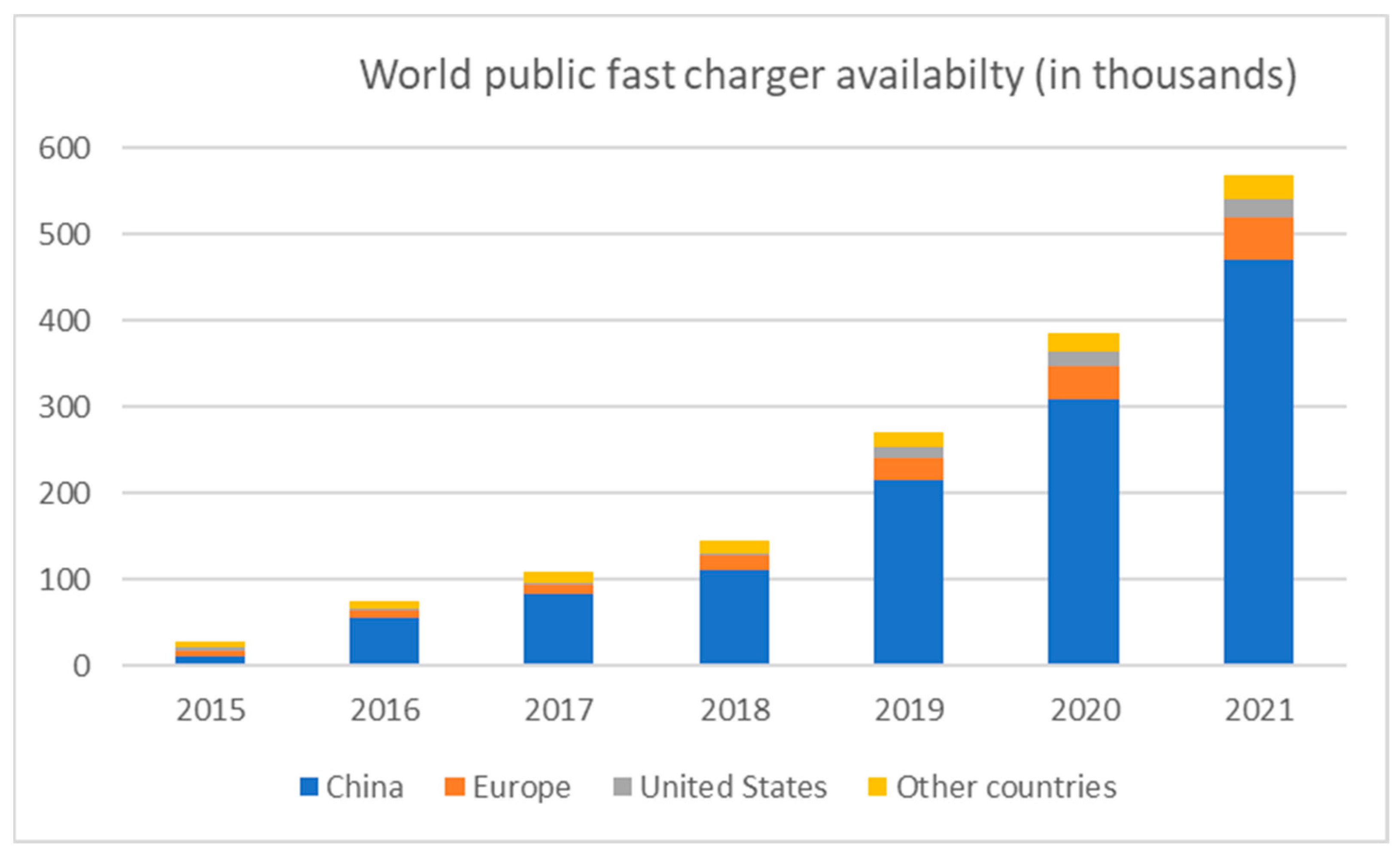



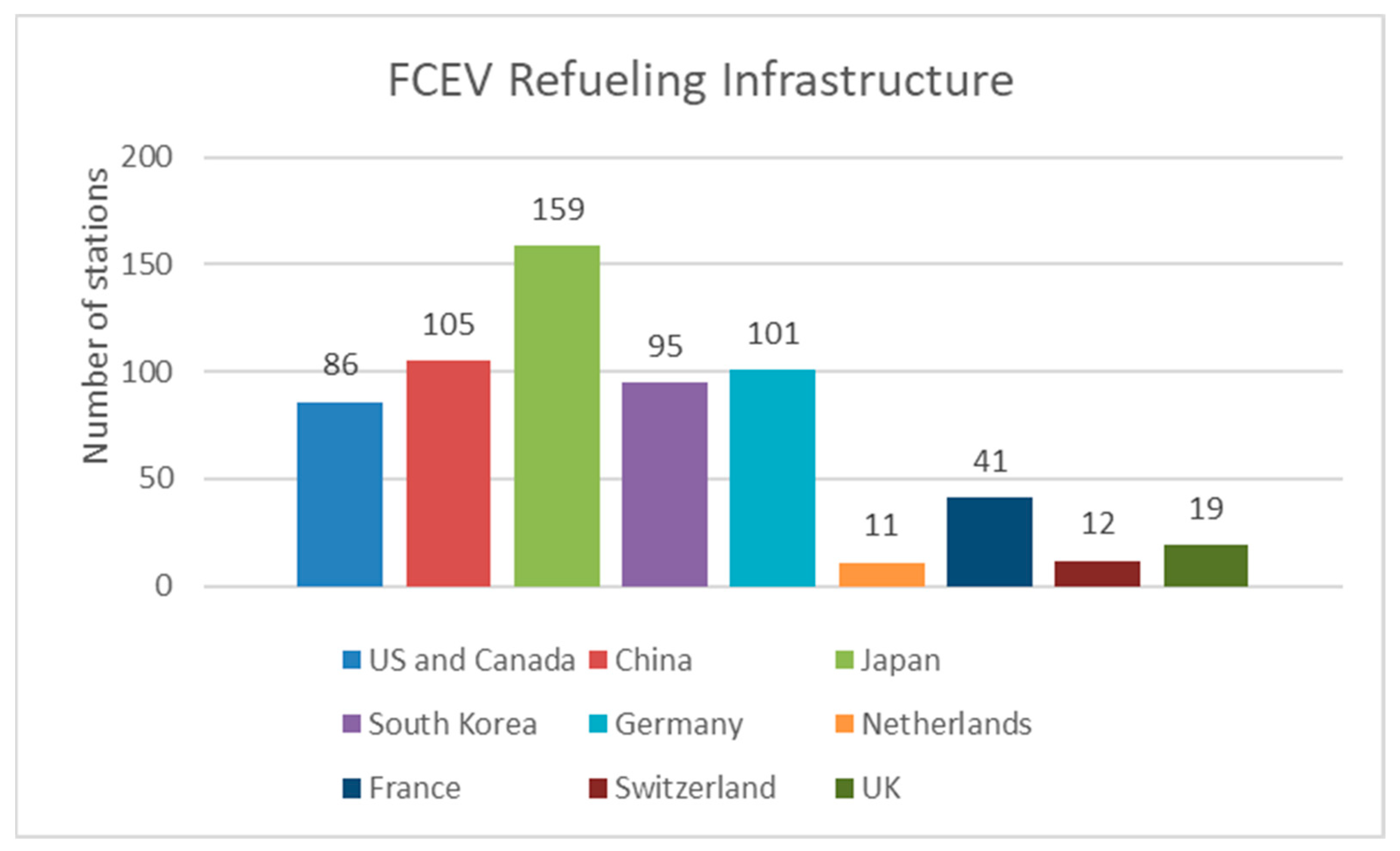

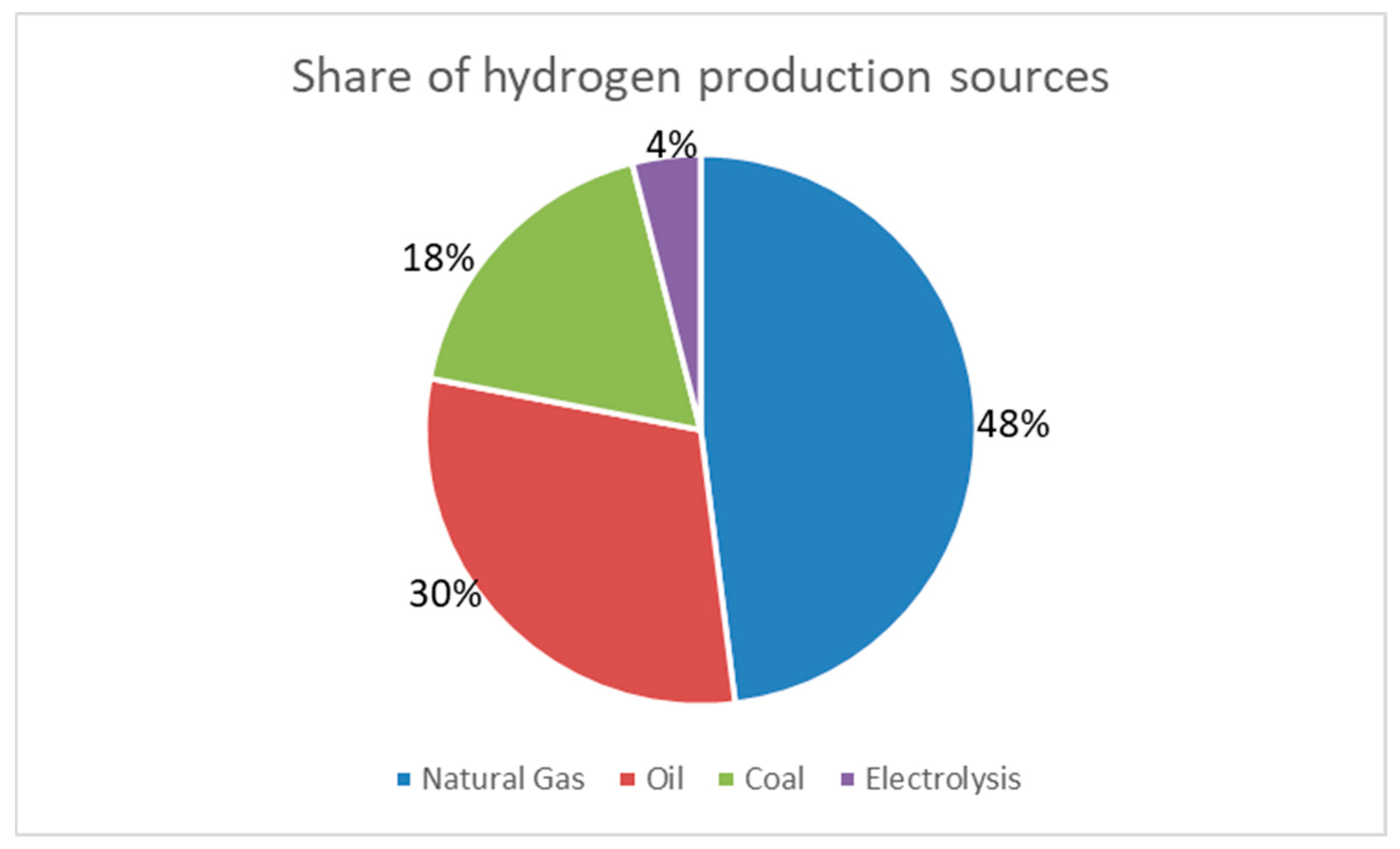
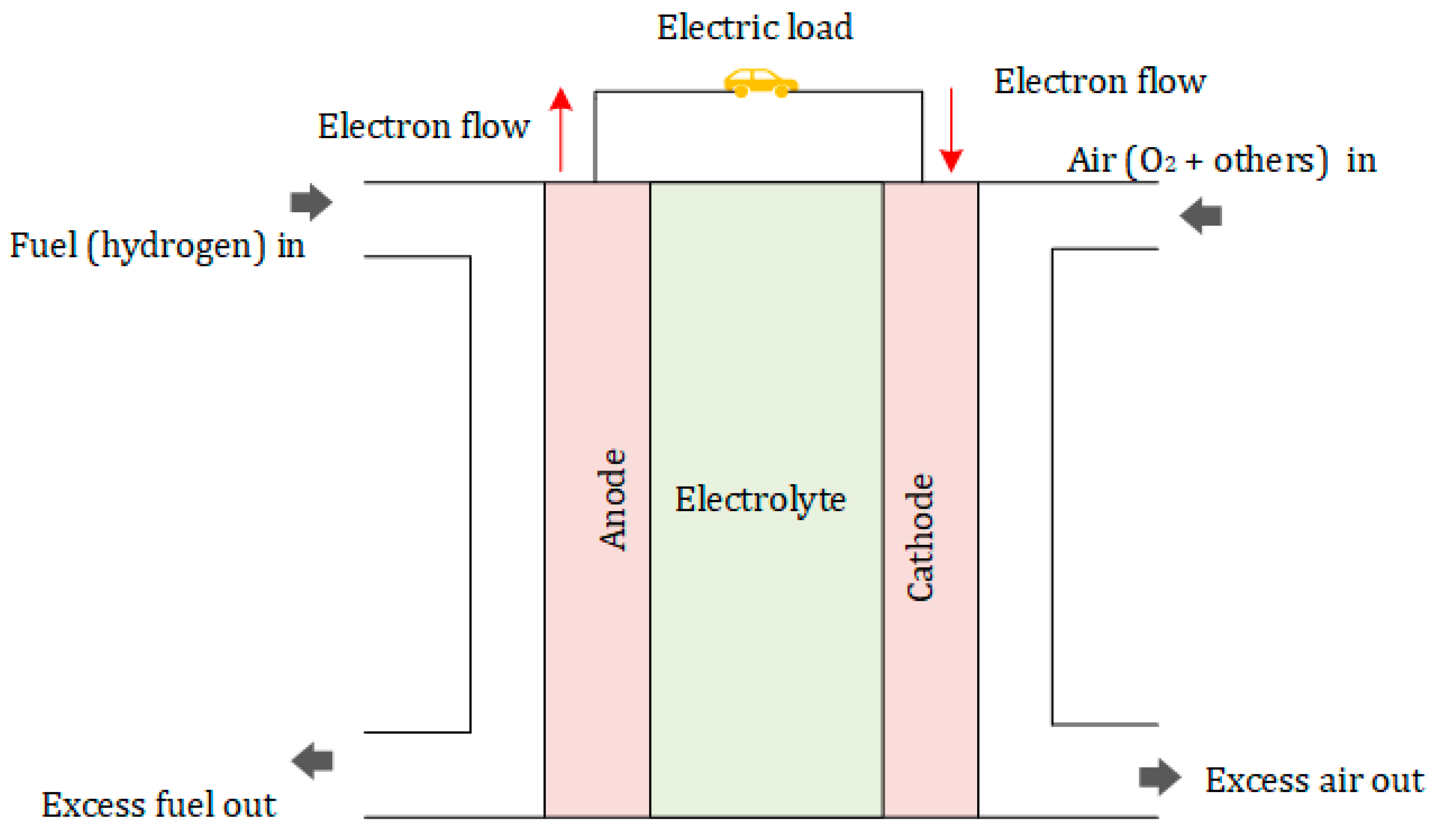
| Type of EV | Popular Examples of EVs |
|---|---|
| BEV | Tesla Model 3, Tesla Model X, Tesla Model S, Model Y, Chevrolet Bolt, Audi e-tron, Nissan Leaf, Kia Niro Electric |
| HEV | Toyota Prius, Audi A3, Kia Niro |
| PHEV | Volt, Mini Cooper SE, Volvo V60, Prius Prime, Volvo S60, Kia Niro Plug-in Hybrid |
| FCEV | Honda Clarity, Toyota Mirai, Tucson |
| Charging Time | Level | Voltage Level (V) | Power Level (kW) | Maximum Current (A) |
|---|---|---|---|---|
| PHEV: 7 h (0–full charge) BEV: 17 h (20%–full charge) | 1 | 120 120 | 1.4 1.9 | 12 16 |
| PEV: 3 h (0–full charge) BEV: 7 h (20%–full charge) | 2 | 208–240 | 3.3 | ≤80 |
| PEV: 3 h (0–full charge) BEV: 7 h (20%–full charge) | 208–240 | 7 | ||
| PEV: 3 h (0–full charge) BEV: 7 h (20%–full charge) | 20 | |||
| 3 * | 240 (1-phase), or 3-phase | >20 | >80 |
| Charging Time | Level | Voltage Level (V) | Power Level (kW) | Maximum Current (A) |
|---|---|---|---|---|
| PHEV: 22 min (0–80%) BEV: 1.2 h (20%–full charge) | 1 | 200–450 | ≤36 | 80 |
| PHEV: 10 min (0–80%) BEV: 20 min (20%–full charge) | 2 | 200–450 | ≤90 | ≤200 |
| BEV: <10 min | 3 | 200–600 | 240 | ≤400 |
| Connector Type | Level | Locations Used | Charging Speeds | Range Added per Hour |
|---|---|---|---|---|
| J1771, Tesla | 1(AC) | Homes, offices, public areas | 3–5 miles/h | 3–5 miles |
| J1771, Tesla | 2(AC) | Homes, offices, public areas | 12–80 miles/h | 12–80 miles |
| Combined charging system (Combo), CHAdeMO, Tesla, GB/T | 3(DC) | Public areas | 3–20 miles/min | 75–1200 miles |
| Standard | Regions Mainly Used | Key Manufacturers | Examples of EVs |
|---|---|---|---|
| Tesla Superchargers | Used by Tesla vehicles only | Tesla | Model 3, Model S, Model X |
| CCS | US, Europe, other parts of the world | BMW, Mercedes-Benz, Audi, Porsche, Ford, Volkswagen | Audi e-tron, BMW i3, Chevrolet Bolt, Honda Clarity, Hyundai Kona, Jaguar I-PACE, Kia Niro, Volkswagen e-Golf |
| CHAdeMO | Japan | Nissan, Mitsubishi, Toyota, Subaru | Kia Soul, Nissan LEAF, Nissan LEAF Plus |
| GB/T | China | SAIC Dongfeng, Geely, Chana, Chery, GAC, FAW, BAIC, BYW | All Chinese-made EVs |
| Country | Number of Slow Chargers | Number of Fast Chargers 1 |
|---|---|---|
| China | 680,000 | 470,000 |
| United States | 92,000 | 22,000 |
| Netherlands | 80,000 | 2600 |
| France | 50,000 | 4500 |
| Germany | 40,000 | 9200 |
| United Kingdom | 30,000 | 7700 |
| South Korea | 90,000 | 15,000 |
| Classification | Objective | References |
|---|---|---|
| Optimal allocation and sizing of EV charging stations | Minimize cost between power transmitter allocation and battery size | [6] |
| Minimize total losses, maximize DG | [44] | |
| EV charging station, and ESS penetration | [49] | |
| Minimize battery, inverter, and cable costs | [43] | |
| Optimal scheduling and routing | Maximize the total residual energy | [50] |
| Minimize system operating costs for wireless electric bus system | [1] | |
| Routing algorithm to extend battery longevity and driving range | [51] | |
| Minimize energy consumption of Evs | [52] | |
| A review | [53] | |
| Communication | Communication between wired and wireless charging systems through IoT | [31] |
| Mobile edge computing model for predicting charging station availability | [54] | |
| Coordinated communication framework for EV charging management | [55] | |
| Power electronics | Optimal coil design | [56,57] |
| Type | Energy Density | Cycle Life (Cycles) | Cost USD/kWh | Self-Discharge Rate (%/Month) | Charging/Discharging Efficiency | Nominal Cell Voltage |
|---|---|---|---|---|---|---|
| Lead acid | 35–40 Wh/kg 80–90 Wh/L [72] | 1500–5000 [72] | 150–200 | 3–20 [77] | 50–95% [78] | 2.1 V [79] |
| Lithium-ion | 150–180 Wh/kg 300–350 Wh/L [72] | 1000–5000 | 600–800 [72] | 0.35–2.5 [80] | 80–90% [81] | 3.6/3.7/3.8/3.85 V |
| Nickel-cadmium | 50–150 Wh/L | 2000 | 400–1000 [66,71] | 10 | 70–90% [81] | 1.2 V |
| Nickel metal hydride | 140–300 Wh/L | 180–2000 [69,70] | 83–400 [66,72] | 13.9–70.7 at room temp. 36.4–97.8 at 45 °C | 66–92% [82,83] | 1.2 V |
| Fuel cell (PEM) | 112.2–770 kWh/m3 [84] | 70–13,000 [84] | 35–45% [75] 60% [14] | 1.2 V [85] |
Disclaimer/Publisher’s Note: The statements, opinions and data contained in all publications are solely those of the individual author(s) and contributor(s) and not of MDPI and/or the editor(s). MDPI and/or the editor(s) disclaim responsibility for any injury to people or property resulting from any ideas, methods, instructions or products referred to in the content. |
© 2023 by the authors. Licensee MDPI, Basel, Switzerland. This article is an open access article distributed under the terms and conditions of the Creative Commons Attribution (CC BY) license (https://creativecommons.org/licenses/by/4.0/).
Share and Cite
Aduama, P.; Al-Sumaiti, A.S.; Al-Hosani, K.H. Electric Vehicle Charging Infrastructure and Energy Resources: A Review. Energies 2023, 16, 1965. https://doi.org/10.3390/en16041965
Aduama P, Al-Sumaiti AS, Al-Hosani KH. Electric Vehicle Charging Infrastructure and Energy Resources: A Review. Energies. 2023; 16(4):1965. https://doi.org/10.3390/en16041965
Chicago/Turabian StyleAduama, Prince, Ameena S. Al-Sumaiti, and Khalifa H. Al-Hosani. 2023. "Electric Vehicle Charging Infrastructure and Energy Resources: A Review" Energies 16, no. 4: 1965. https://doi.org/10.3390/en16041965






